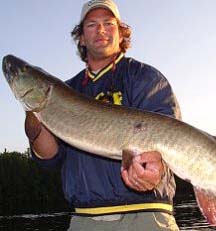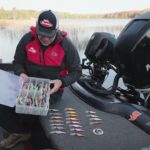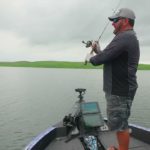Up and Bumping Bulger Bucktails In-between Baits for In-between Times
 Some baits just don’t fit into any one category. Sorta like this, but some of that too; can do one thing almost as well as this, but has some things this doesn’t and that does but these aren‘t really this, or entirely that either, so what is it, exactly? Enough to make a guy dive for the plain lead jigheads, no paint or nothing, thanks, deciding on color right now is enough to make my head hurt. Some baits, well, they’re just sort of in-between.
Some baits just don’t fit into any one category. Sorta like this, but some of that too; can do one thing almost as well as this, but has some things this doesn’t and that does but these aren‘t really this, or entirely that either, so what is it, exactly? Enough to make a guy dive for the plain lead jigheads, no paint or nothing, thanks, deciding on color right now is enough to make my head hurt. Some baits, well, they’re just sort of in-between.
Lots of things in fishing like that. When it comes to the nuts and bolts of it, a lot of the really important things in fishing-the bare bones, keep your whiz-bang theories and gimme the where, when, and how basics-that we talk and think about are about what’s in-between. Shallow flats covered with scattered coontail that aren’t really a solid weedbed but rather a multitude of individual weedlines, pockets, points and inside turns, each one an edge in miniature where you can spend an afternoon poking and probing and not ever crank the outboard. Shallow flats of mixed cabbage and sandgrass that aren’t quite barren flats, but aren’t thick jungle either. Thick weedbeds that grow to the edge of the breakline, then fade into the abyss. Hard- to soft-bottom transitions at the edge of a main-lake basin that somehow attract suspended forage and open water muskies.
Edges in time too, both seasonal and daily. Transition periods in the biological cycle of predator and prey; short, sharp disruptions in periods of relative stability, like the few short hours before an approaching midsummer storm. The prime time twilight of dawn and dusk. Edges and transitions, fishing 101 heart and soul.
Some muskie baits, and really some of the best, are also parked firmly in the in-between. A prime example? Large hybrid plastics like the Bull Dawg; not quite a jerkbait, not quite a jig, but rather a little bit of most of the best of both. Baits like Bull Dawgs and bulger bucktails, with characteristics and capabilities lying just a little outside the norm, carry with them the traits of several different bait styles, and along with that a versatility that goes beyond the basic applications of their more traditional cousins. They aren’t radically different, but rather variations on a combination of themes-fusion, with hooks.
From three feet away, bulger bucktails look enough like a garden variety bucktail to escape notice by many muskie anglers prowling the isles of the tackle shop. Some sort of body-hair, or maybe a wad of feathers-blade, coupl’a hooks. Yep. Bucktail, period. Got a million of ‘em.
Look a little closer though, or better yet, get one in the water, and it’s a different story. Bulger bucktails are different enough to warrant some consideration in their own right, and why that’s true is not only how they are built, but what they do.
Bulger Builds
A good bulger bucktail differs from standard bucktails in a handful of key areas:
Light Weight – Bulgers are generally lighter overall than most bucktails. Less lead allows them to rise quickly to where they belong (just under the surface) even at slower speeds.
Body Material or Tying Style – Lighter weight, while great for getting baits up on top in a hurry, can cause problems in other areas though, mainly castability. A bucktail that’s simply on the light side can be a good bulger under calm conditions, but be next to impossible to cast any distance or with any accuracy in even a moderate wind. A couple of the best bulgers builders out there, Bruce Shumway and Dave Dorazio, counter the castability issue by using marabou rather than bucktail as a body material. Dorazio Comboo Boo TailA pile of dry marabou bulgers looks like an industrial accident at a pillow factory (and casting one without wetting it down first is a guaranteed whopper of a backlash) but once the marabou becomes water soaked, it mats down to next to nothing out of the water, making for a package only slightly less aerodynamic and castable than a leadhead jig, even in a fairly stiff wind. Other manufacturers counter light weight with traditional bucktail applied in a non-traditional way. Brian Miller’s Bird-D (alas, a bait that is no longer being produced…) and Musky Maina Tackle’s Sneaky Pete are both reverse-tied-that is, the bucktail dressing is tied to the spinner shaft at the hook with the tips of the bucktail pointing toward the blades, rather than below the blades pointing toward the hooks, so the bait appears to be tied backwards. When cast, the narrower bullet profile cuts the air much better than a standard tied tail, even though the bucktail itself is still fairly bulky.
 Cast Small, Look Big – While marabou bodies or reverse-tied bucktails solve one big challenge for good bulgers-castability-the unusual body styles don’t just matter in mid-air. Both styles also create effects in the water important to good bulgers-a large profile. Marabou tails like Shumway’s Flasher and Dorazio’s Comboo give the illusion of mass in the water, pulsating with each rotation of the blades. Reverse-tied tails fold over backwards while retrieved, again creating the appearance of something considerably larger than it actually is.
Cast Small, Look Big – While marabou bodies or reverse-tied bucktails solve one big challenge for good bulgers-castability-the unusual body styles don’t just matter in mid-air. Both styles also create effects in the water important to good bulgers-a large profile. Marabou tails like Shumway’s Flasher and Dorazio’s Comboo give the illusion of mass in the water, pulsating with each rotation of the blades. Reverse-tied tails fold over backwards while retrieved, again creating the appearance of something considerably larger than it actually is.
Musky Mania Tackle Sneaky PeteMultiple Blades – Bulgers often (though not in all cases, the Bird-D being one example) have multiple blades. Paired blades (Colorado blades on the Flasher and Comboo, and Indianas on the Sneaky Pete) create a lot of lift-even at slow speeds-and allow the baits to bulge the surface without popping out of the water. Double blades are sometimes enough to scare off would-be bulger buyers. If one #8 Colorado is work to retrieve, two must be murder, but in reality, that’s not the case. Not sure why exactly, but two large blades actually seem easier to retrieve than a single blade of the same size. One fishing partner of mine has suggested that it’s simply a matter of one blade “cutting a path” for another, and he may be right. Whatever the cause, paired blades don’t seem to add a great deal of resistance to the retrieve-while greatly increasing the amount of water a bulger pushes without actually breaking the surface.
 The combination of body design and multiple blades creates something quite a bit different than an ordinary bucktail. A bulger pops right to the surface, pushing water, throwing a wake, gurgling and burping, and generally making a fuss. Topwaters do this of course, but bulgers do it different, staying mostly underwater and only just breaking the surface if at all, and all the while flashing and thumping like a good bucktail should.
The combination of body design and multiple blades creates something quite a bit different than an ordinary bucktail. A bulger pops right to the surface, pushing water, throwing a wake, gurgling and burping, and generally making a fuss. Topwaters do this of course, but bulgers do it different, staying mostly underwater and only just breaking the surface if at all, and all the while flashing and thumping like a good bucktail should.
I should say too-and I think it’s important and part of why bulgers can be as effective as they are-that where bulger bucktails do their thing is yet another in-between: the surface itself, something Canadian muskie expert and former fisheries biologist Gord Pyzer once called “the most obvious and overlooked edge of all.” If you’ve read the article in this issue co-written by Dick Pearson, Doug Johnson and Jack Burns on fishing pressure, you’ll see in there several discussions on either overlooked or hard to target in-betweens-among them, the surface itself.
Why Bulgers? So why not just throw a surface bait? Good idea a lot of the time. Can’t you bulge a regular bucktail? Some of them bulge quite well, and to be fair, popping almost any bucktail to the surface for a few feet during the retrieve is almost always a good idea, and will catch you more fish.
Bulgers, though, work in the in-between of those two options, pushing the surface and creating a disturbance like a topwater, while the body of the bait stays submerged. One benefit of this seems to be better hooking percentages than most topwaters. I’m not sure why, but my suspicion is that Hittin the Topit’s a combination of a good-hooking bait style in general (no bulky body to get in the way) and how the baits come through the water. Since bulgers don’t completely break the surface, it may be that the profile of the bait is less broken up by churning water, providing a better target and all the while moving in a nice straight line. Whatever the cause, you seem to get fewer short hitting blow-ups with bulgers than with most topwater styles. The ability to manipulate the speed of bulgers also gives them an advantage over simply bulging a standard tail. Most any bucktail can be bulged, but it’s usually a high-speed proposition, and keeping them on top without blowing out can be a challenge. The high lift of double blades and light weight make it easier to keep bulgers on the surface at a wider range of speeds. Point the rod tip at the water, and you can burn a bulger almost as fast as you can turn the handle without blowing out, or hold the rod tip high to creep the bait along and still keep the bait on top and throwing a wake.
When and where for bulgers? Lots of options really, though I can offer a few suggestions. Bulgers shine as throw-back baits to fish that have followed other lures. Slow-moving topwaters are a traditional throw-back trick, and with good reason. But bulgers have the advantage of a speed range a lot of topwaters lack, not to mention a higher hooking percentage. Over the past couple seasons, bulgers have become my throwback bait of choice.
Early summer-really an in-between time period-is another great time for bulgers. Work bulgers over the tops of developing weedbeds, experimenting with a variety of retrieve speeds. Bulgers stay up over the tops of weeds, reducing wasted casts, and can move fish not quite cranked up enough to chase traditional topwaters, especially in the prime time twilight period when light levels are reduced and water temperatures peak for the day.
 Bulgers are also a tool for countering heavy pressure. Leech Lake area guide and frequent EA contributor Dan Craven has long suggested that fish seem to become less conditioned to topwater or near-surface presentations, and it’s not an accident that two of the best bulgers out there are manufactured by guides making their living fishing the heavily-pressured waters of the Hayward, Wisconsin area. For fish that can spell “M-e-p-p-s” by mid-July, bulgers can be a different twist in situations where traditional bucktails would get the nod on less-pressured waters.
Bulgers are also a tool for countering heavy pressure. Leech Lake area guide and frequent EA contributor Dan Craven has long suggested that fish seem to become less conditioned to topwater or near-surface presentations, and it’s not an accident that two of the best bulgers out there are manufactured by guides making their living fishing the heavily-pressured waters of the Hayward, Wisconsin area. For fish that can spell “M-e-p-p-s” by mid-July, bulgers can be a different twist in situations where traditional bucktails would get the nod on less-pressured waters.
In-between baits like bulgers, by their very nature, invite experimentation. The versatility they gain by combining traits from different bait styles make them a tool that can be applied to a number of situations beyond the few described here. Spend a little time splashing around in the in-between, and you’re bound to find the value of variations on even the most tried and true of muskie themes.





